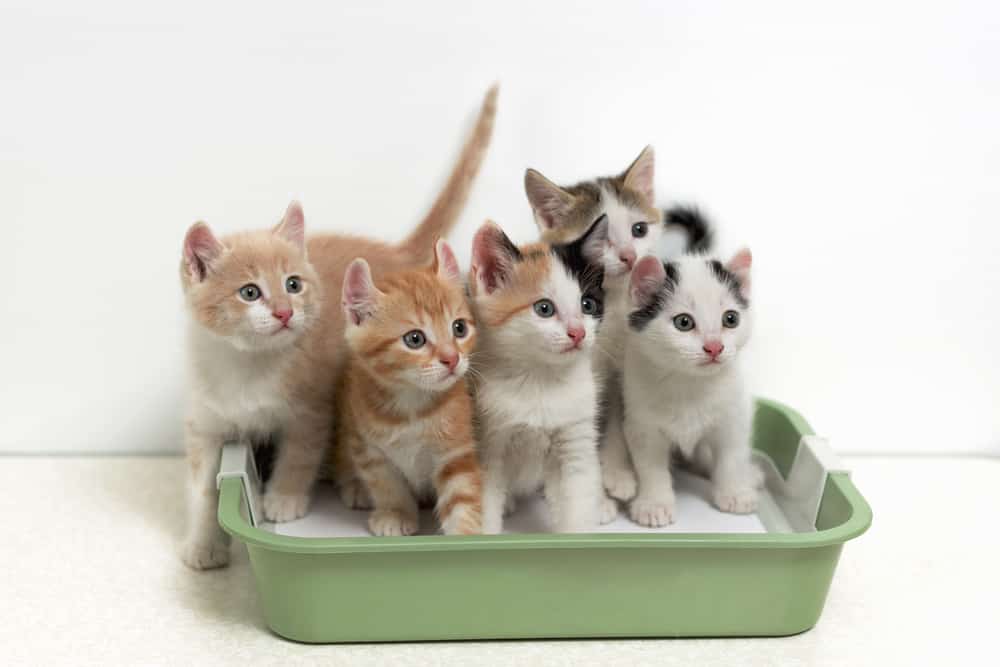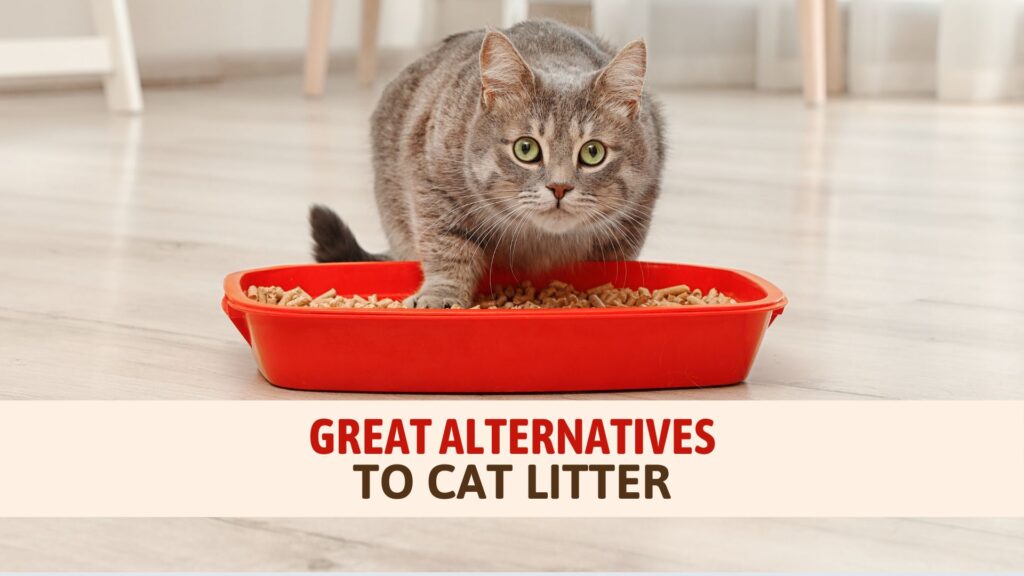It seems like there's a special litter for just about every situation out there.
From wood pellet litter to recycled grass and even recycled newspaper, our cats can poop on just about anything they could imagine these days!
But what about good ol' dirt? Can you use dirt, sand, or soil as cat litter?
Yes, you can use dirt, sand, or soil as cat litter although there are some major downsides to this approach and it's rarely the best long term choice. While it can be very cost-effective, it's not always convenient, and exposing indoor-only cats to dirt from the outside could be dangerous.
The idea is simple enough, but there might be more to consider than you'd think at first glance. You might also be surprised to find that store-bought litter or wood pellets are usually cheaper than buying sand at the store.
So let's take a closer look at everything you need to know about using dirt, sand, or soil as your natural DIY litter.
Is It Safe To Use Dirt, Sand, Or Soil As Litter?
Before we consider cost or convenience, we first need to consider the safety of using dirt or soil as litter.
If your cat already spends time outdoors and regularly uses the dirt or sand outside as a toilet, then there's not much difference in bringing some of that sand inside- at least from a safety perspective.
But if your cat is indoor-only, bringing in outdoor soil could expose them to a variety of internal parasites and viruses. The most concerning of which are feline panleukopenia and toxoplasmosis.
Feline Panleukopenia
I know, it might sound a litter over the top to suggest that letting your cat poop on outside dirt could lead to a fatal disease but there are dozens of studies all showing how feline panleukopenia can easily survive in soil or other parts of the environment for more than a year.
That's one of the many reasons why this disease is so problematic for our feline friends and once panleukopenia (often called panluek or sometimes FPV) is in the environment it's very hard to remove unless you're dealing with only non-porous surfaces.
In other words, surfaces that are the opposite of soil and one study elaborates on this when they explain that “Disinfection of soil is not practical, and objects with porous surfaces, such as carpeting, should be steam cleaned or removed from the environment.”
So how does panleukopenia end up in sand, soil, or dirt in the first place?
The virus is typically shed via the stool but the virus can also be shed via urine.
While this all sounds bad, and it is, the good news is that we have very effective vaccines to fight feline panleukopenia. Thankfully, it's a core vaccine which means if your cat has ever been the veterinarian or came from a shelter there's a very good chance they've had it.
But before bringing in dirt from the outside for your indoor cat, make sure your cat is vaccinated against panleukopenia.
Toxoplasmosis
Toxoplasmosis is a disease caused by a single-cell organism and it's one of the most common parasites across the globe. While it is possible for toxoplasmosis to be found in and transmitted via soil cats more commonly contract this disease by eating infected meat or as the folks at Cornell Veterinary plainly put it “Indoor cats that do not hunt prey or consume raw meat are unlikely to be infected with T. gondii [parasite that causes toxoplasmosis]”.
Still, toxoplasmosis can live several months in the soil and the risk is obviously higher if you're using soil that cats are regularly pooping in instead of outdoor litter boxes.
Isn't Store Bought Soil or Dirt Clean?
Well, it is dirt still!
But it really depends on what kind you buy. For example, potting soil is often a carefully crafted combination of different compounds designed to make gardens grow. That could be better or worse for litter boxes depending on what's in that specific potting soil.
Dirt can come from all over the place and most sand actually comes from a quarry which makes it a good choice for avoiding toxoplasmosis and panleukopenia.
But wherever it comes from, it's typically not sterilized or sanitized before being brought to the store so don't assume that just because it's all packaged up that it's “clean”.
So Is Sand, Soil, Or Dirt Safe?
Unfortunately, there's not going to be a 100% clear answer here and it will depend on where the sand, soil, or dirt comes from. You'll also want to bring your veterinarian into the conversation and make sure that your cat is up to date on their vaccines.
When it comes to dirt or sand from your backyard, the chance of toxoplasmosis or panleukopenia is likely higher than sand that's from a quarry. While cats are found all over the world, most wouldn't choose to set up shop at a quarry. If you already have community cats roaming your neighborhood, and your cat isn't one of them, then it's a good idea to skip the dirt from your backyard altogether.
If instead, you decided to go the store-bought route, you have to ask yourself if just going for litter or an easy-to-manage option like wood pellet litter may make more sense. While you can find sand that's specifically made for children (and so it's more likely to be safer for cats) when you look at the price of these options on Amazon you quickly realize that you'd be better off picking out some premium litter.
So in short, the safety will depend on what type of dirt, sand, or soil you pick out and there are simply too many options to break down in this article.
What's Good About Using Dirt As Litter?
Why would want to use dirt as litter in the first place? Let's talk about the two big benefits of going this route.
It's Cheap
Some might even say that it's cheap as dirt.
Okay, sorry.
No more dirt puns but this is clearly the biggest benefit- at least in most cases. We've already seen that high-quality and human-safe sand can cost quite a bit but if you're digging up dirt from your backyard then nothing will be cheaper than that.
But as we've also already seen, you may be sacrificing safety for cost savings when you really don't have to.
Many Cats Will Love It
Cats have been pooping in the dirt for a lot longer than they've been digging up litter for a bathroom break so there's a good chance your cat will be happy to potty in your potting soil.
In fact, cats love pooping in gardens and it's a big problem for many gardeners.
So your cat will probably be pretty pleased that you've decided to go au naturale with their litter.
What Are The Downsides To Using Dirt As Litter?
The list of upsides was short…but the list of downsides is much longer so let's break down a few of the big issues.
It Can Be Very Messy
Besides the smell, the next biggest frustration most people have with litter boxes is the issue of litter getting tracked around the house. Opting for a unique litter box placement (like in the bathtub) can help but with sand or dirt the entire process becomes more difficult.
It doesn't take much to get sand everywhere whether that's when you fill the box or when your cat launches themself out of the box!
Cats Like Consistency
If you're going the store bought route for dirt and sand then keeping things consistent is simple enough. But if you're digging up dirt from the backyard then you may run into problems keeping the right consistency for your cat. Most cats may not care but some will and it's the same reason why we don't advise mixing two types of cat litter.
Low Technology Means No Clumping or Odor Control
No matter where you're getting your dirt or sand, you won't be getting the benefits of clumping litter or odor control that you would from going for traditional litter. While you can come up with some clever ways to reduce odors in the litter box, there's no getting around the lacking of clumping.
Sand Can Be Heavy
Obviously, 40 pounds of cat litter and 40 pounds of sand weigh the same but the big difference is just how far those 40 pounds will go.
Cat litter is designed to be porous and absorbant which usually makes it pretty light, relatively speaking. While potting soil and anything with peat moss mixed in will be porous as well, dirt and sand aren't.
If you're getting sand or dirt from the backyard, you'll need to be ready for a workout if you're going to try and stock up. And if you're picking it up from the store, you need to be prepared to use more sand per litter box fill than you would with traditional litter which means more heavy hauling.
So unless your supply of sand is right outside your backdoor, this can end up being quite a hassle.
Dirt Is…Dirty!
While dirt will also be heavy it's also likely to contain all kinds of undesirable organic matter. Poop from other animals is already bad but decaying matter is likely to be present as well. That means you'll not only miss out on the odor control that commercial cat litter offers, but you'll potentially bring in some stinky stuff from outside too.
Potting Soil Is Expensive
Out of the three main options, potting soil is the best choice since it's carefully formulated, porous and lightweight.
But it also has one big downside and that's the price. Potting soil isn't cheap and for many people, that's going to be an immediate deal-breaker.
What Are The Alternatives?
Maybe sand or dirt isn't looking as appealing as it once did…so what are your other options?
The first thing to go for is a commercial cat litter that has a sand-like consistency. A great place to start is with Arm & Hammer's Clump and Seal Platnium Litter which you can see on Amazon by clicking here.
There are dozens of folks who compare the consistency of this litter to sand so if that's your cat's preference this could be a great pick. Even better, you'll also get the benefits of some serious clumping power. It also offers great odor control (certainly more than plain sand) which is why this litter also made our list of the best cat litters for small studios and apartments.
That's far from your only option if you're looking for a sand-like consistency and if instead, you're just looking for a more natural or eco-friendly then wood pellet litter is worth checking out. While it may not have the clumping power of traditional litter, if you buy from your local feed store you can usually get a 40-pound bag for around 5 dollars.
Sure, that's not as cheap as free dirt in your backyard but it's pretty darn close to it!
So Should You Use Dirt, Sand, Or Soil As Litter?
While it's possible to use in a pinch and can make a great option if you suddenly run out of litter, using sand, dirt, or soil as your main litter choice isn't a great option.
Unless you're collecting it yourself, it's probably not as cheap as you'd expect and it's far from convenient. Sand and dirt especially are easy to track around the house, hard to clean up, and don't offer any of the benefits you get from commercial litter.
If your cat is usually indoor-only, there's also the additional risk of exposing them to parasites and diseases from outside.
So even though you can use dirt, sand, or soil as litter it's probably best to skip it!
Read Next: Can I Use Baby Wipes On My Cat?





